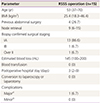1. Autorino R, Cadeddu JA, Desai MM, Gettman M, Gill IS, Kavoussi LR, et al. Laparoendoscopic single-site and natural orifice transluminal endoscopic surgery in urology: a critical analysis of the literature. Eur Urol. 2011; 59:26–45.

2. Gettman MT, White WM, Aron M, Autorino R, Averch T, Box G, et al. Where do we really stand with LESS and NOTES? Eur Urol. 2011; 59:231–234.

3. Park JY, Kim DY, Suh DS, Kim JH, Nam JH. Laparoendoscopic single-site versus conventional laparoscopic surgical staging for early-stage endometrial cancer. Int J Gynecol Cancer. 2014; 24:358–363.

4. Fagotti A, Boruta DM 2nd, Scambia G, Fanfani F, Paglia A, Escobar PF. First 100 early endometrial cancer cases treated with laparoendoscopic single site surgery: a multicentric retrospective study. Am J Obstet Gynecol. 2012; 206:353.e1–353.e6.
5. Boruta DM, Fagotti A, Bradford LS, Escobar PF, Scambia G, Kushnir CL, et al. Laparoendoscopic single-site radical hysterectomy with pelvic lymphadenectomy: initial multi-institutional experience for treatment of invasive cervical cancer. J Minim Invasive Gynecol. 2014; 21:394–398.

6. Fader AN, Escobar PF. Laparoendoscopic single-site surgery (LESS) in gynecologic oncology: technique and initial report. Gynecol Oncol. 2009; 114:157–161.

7. Fader AN, Cohen S, Escobar PF, Gunderson C. Laparoendoscopic single-site surgery in gynecology. Curr Opin Obstet Gynecol. 2010; 22:331–338.

8. Uppal S, Frumovitz M, Escobar P, Ramirez PT. Laparoendoscopic single-site surgery in gynecology: review of literature and available technology. J Minim Invasive Gynecol. 2011; 18:12–23.

9. Spana G, Rane A, Kaouk JH. Is robotics the future of laparoendoscopic single-site surgery (LESS)? BJU Int. 2011; 108:1018–1023.

10. Tang B, Hou S, Cuschieri SA. Ergonomics of and technologies for single-port lapaxroscopic surgery. Minim Invasive Ther Allied Technol. 2012; 21:46–54.

11. Kaouk JH, Goel RK, Haber GP, Crouzet S, Stein RJ. Robotic single-port transumbilical surgery in humans: initial report. BJU Int. 2009; 103:366–369.

12. Hubert N, Gilles M, Desbrosses K, Meyer JP, Felblinger J, Hubert J. Ergonomic assessment of the surgeon's physical workload during standard and robotic assisted laparoscopic procedures. Int J Med Robot. 2013; 9:142–147.

13. Murji A, Patel VI, Leyland N, Choi M. Single-incision laparoscopy in gynecologic surgery: a systematic review and meta-analysis. Obstet Gynecol. 2013; 121:819–828.
14. Escobar PF, Fader AN, Paraiso MF, Kaouk JH, Falcone T. Robotic-assisted laparoendoscopic single-site surgery in gynecology: initial report and technique. J Minim Invasive Gynecol. 2009; 16:589–591.

15. Sendag F, Akdemir A, Zeybek B, Ozdemir A, Gunusen I, Oztekin MK. Single-site robotic total hysterectomy: standardization of technique and surgical outcomes. J Minim Invasive Gynecol. 2014; 21:689–694.
16. Lambaudie E, Cannone F, Bannier M, Buttarelli M, Houvenaeghel G. Laparoscopic extraperitoneal aortic dissection: does single-port surgery offer the same possibilities as conventional laparoscopy? Surg Endosc. 2012; 26:1920–1923.

17. Siegel R, Naishadham D, Jemal A. Cancer statistics, 2012. CA Cancer J Clin. 2012; 62:10–29.

18. Suh DH, Kim K, Kim JW. Major clinical research advances in gynecologic cancer in 2011. J Gynecol Oncol. 2012; 23:53–64.

19. Wright JD, Barrena Medel NI, Sehouli J, Fujiwara K, Herzog TJ. Contemporary management of endometrial cancer. Lancet. 2012; 379:1352–1360.

20. Sinno AK, Fader AN, Tanner EJ 3rd. Single site robotic sentinel lymph node biopsy and hysterectomy in endometrial cancer. Gynecol Oncol. 2015; 137:190.

21. Vizza E, Corrado G, Mancini E, Baiocco E, Patrizi L, Fabrizi L, et al. Robotic single-site hysterectomy in low risk endometrial cancer: a pilot study. Ann Surg Oncol. 2013; 20:2759–2764.

22. Shin SJ, Chung H, Kwon SH, Cha SD, Cho CH. New suturing technique for robotic-assisted vaginal cuff closure during single-site hysterectomy. J Robot Surg. 2017; 11:139–143.

23. Montz FJ, Holschneider CH, Munro MG. Incisional hernia following laparoscopy: a survey of the American Association of Gynecologic Laparoscopists. Obstet Gynecol. 1994; 84:881–884.










 PDF
PDF ePub
ePub Citation
Citation Print
Print





 XML Download
XML Download